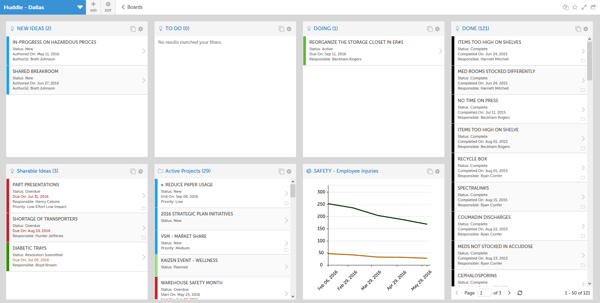 While the quality of care and the patient experience has long been a top priority for healthcare organizations, increasingly they are turning to more formal, systematic approaches to continuous improvement. The goal is to ensure the best health outcomes while constraining costs and maximizing resources.
While the quality of care and the patient experience has long been a top priority for healthcare organizations, increasingly they are turning to more formal, systematic approaches to continuous improvement. The goal is to ensure the best health outcomes while constraining costs and maximizing resources.
To achieve their ambitious goals, many hospitals and healthcare networks have implemented quality improvement software that supports improvement and strategy deployment techniques. This post is a resource for any healthcare leader considering adopting technology to streamline improvement efforts.
Essential Features of Quality Improvement Software for Healthcare
There are a bunch of project management and collaboration software products available. Most have features for task scheduling and document sharing, but not all are designed to address the specific needs of healthcare organizations focused on daily improvement. The following features set quality improvement software apart from generic solutions.
Opportunity Capture
In healthcare, continuous improvement means that clinical and administrative staff are responsible for identifying and reporting opportunities for improvement. Quality management software provides the platform for collecting each observation. Opportunity collection is so fundamental that it must be easy for any team member to enter a new opportunity with all relevant details and documentation. Healthcare organizations don’t take time off so the solution will be online and available 24x7 from any location.
Online Huddle Boards
Huddles are a popular daily management technique used in healthcare. Teams gather around a whiteboard or poster that visualized the current progress of improvement work. Quality improvement software takes this idea to the next level by hosting digital huddle boards that show more than just the current state. Users can drill down into each item for the historic record and check the long-term impact of completed projects. Teams that want to continue standing meetings can use digital wallboards to make it interactive.

Notifications and Alerts
Healthcare providers are accustomed to receiving alerts when a patient’s vital signs or lab values are out of the expected range. Similarly, healthcare leaders and managers must be warned when their attention is needed for improvement work.
The best quality management software solutions provide a workflow for every in-progress opportunity. The relevant people receive alerts and notifications when a task is due, or a deadline is exceeded. This ensures that no ball is dropped and that everyone is actively engaged in improvement.
Impact Reporting
Most healthcare organizations rely on data and require quantifiable evidence that an improvement has achieved the desired results. Software with impact analytics gives you insight into whether your improvement initiatives are moving the needle regarding specific strategic goals. Quality improvement software is the best way to track the impact of changes over the long term.
Engagement and Activity Reporting
Building a quality-centric culture in healthcare takes time and effort. To understand how the improvement mindset is spreading, leaders need information about the engagement level of each department, team, and individual. Quality management software provides a window into activity and engagement. Leaders and managers can identify trends in key metrics like the number of new opportunities submitted, the number of completed activities, and how often the system is used.
Success Announcement
The fastest way to spread quality-first thinking is to recognize and reward the people who are driving the effort for positive change. The best improvement management software solutions for healthcare have built-in success broadcasting to make it easy for managers to let everyone know when good things start to happen.
Business Terms
These features are all fundamental, but they aren’t the only important considerations for healthcare organizations looking to structure quality improvement. It is also essential to look for a solutions provider that will be a good partner and help spread success in your organization. Consider:
Onboarding and Ongoing Support
We recommend opting for a vendor that will provide you with a dedicated account manager to ensure a successful implementation. You should ask questions about whether you will have help during configuration and deployment and what ongoing email and telephone support will look like.
Other Healthcare Customers
Healthcare organizations are unique and not every solution that works for other kinds of businesses is a good fit for healthcare. It’s smart to talk to the vendor about their experience with healthcare organizations and look for a provider that has clients similar to you.
Self-Help Documentation and Video Learning
It is important to have live training when you implement the solution, but turnover in healthcare is common, so opt for a solution with a user-friendly knowledge center complete with video training so that you can get new team members productive quickly.
Quality improvement culture has the power to transform healthcare organizations by achieving ideal patient outcomes, reducing costs, and harnessing the collective wisdom of every team member. Improvement software paves the way for these crucial goals.




Add a Comment